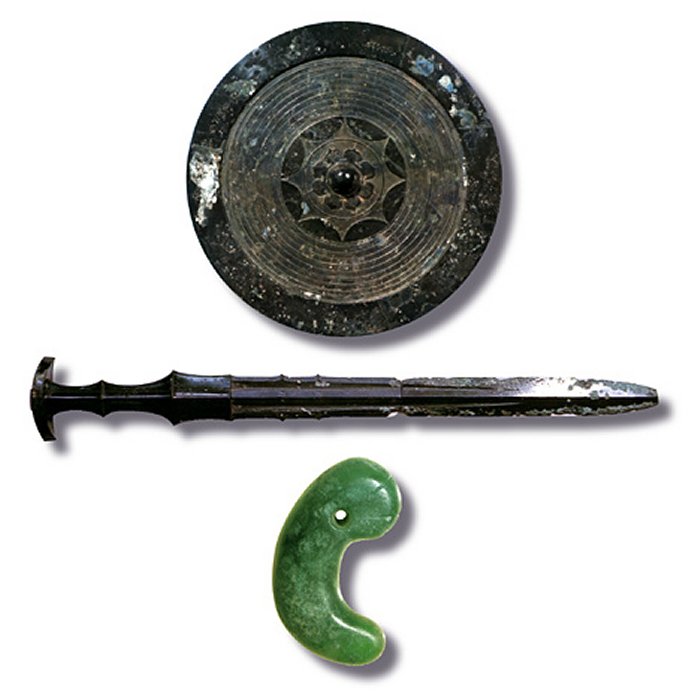Ellen Lloyd - AncientPages.com - Whether the mysterious Kusanagi treasure exists or not remains unknown.
The precious Japanese treasure is allegedly kept in safety at Atsuta Shrine in Nagoya, but since the Shinto priests refuse to show the legendary sword to the public it’s very difficult to confirm the treasure’s historical references. Therefore, it is fair to say that the Kusanagi treasure remains shrouded in a veil of mystery and secrecy.
Legend Of The Kusanagi Sword
According to Japanese mythology, the Kusanagi is a magical sword that the sun goddess gave to her grandson Ninigi when he descended to earth to become ruler of Japan, thus establishing the divine link between the imperial house and the sun. The sword, along with the mirror and jeweled necklace, still forms one of the three Imperial Treasures of Japan. The Imperial Family is identified with three sacred objects such as the mirror, sword and curved jewel.
One day, the storm god Susanoo discovered the Kusanagi in the body of the eight-headed dragon (which he killed) and gave the sword to his sister Amaterasu to settle an old grievance.
Generations later, in the reign of the Twelfth Emperor, Keikō, Ame-no-Murakumo-no-Tsurugi the magical sword was given to the great warrior, Yamato Takeru.
Yamato Takeru used the sword to escape a hunting expedition and he soon became aware of the sword’s remarkable powers. He noticed that the Kusanagi gave him control of the wind and caused it to move in the direction of his swing. Taking advantage of this magic, Yamato Takeru used his other gift, fire strikers, to enlarge the fire in the direction of his enemies, and he used the winds controlled by the sword to sweep the blaze toward them.
Historical Accounts Of The Kusanagi
The first mention of the Kusanagi appears in the Kojiki, a book featuring several Japanese myths. However, the Kojiki is not considered to be a historical document. The first reliable historical mention of the sword is in the Nihonshoki that features Japanese myths and historical events that took place in ancient Japan.
In the Nihonshoki, the Kusanagi was removed from the Imperial palace in 688 and moved to Atsuta Shrine after the sword was blamed for causing Emperor Temmu to fall ill.
Is The Legendary Kusanagi Kept At The Atsuta Shrine?
The Atsuta Shrine has been one of the greatest centers of worship in Japan from ancient times. It was originally founded about 1900 years ago, when the sacred sword Kusanagi -no-tsurugi, one of the Imperial symbols, was enshrined. Atsuta was chosen as the site for the shrine by Miyasuhime-no-Mikoto, daughter of Owari-no-kuni-no-miyatsuko and wife of the then Prince Yamatotakeru-no-Mikoto, who had died leaving the sword in Hikami.
Atsuta Shrine in Nagoya dates back to c. 100 CE during the reign of Emperor Keikō and houses the Kusanagi sword. Image credit: Wikipedia
The Atsuta Shrine ranks second only to the Great Shrine of Ise.
Although the Kusanagi is allegedly kept at Atsuta Shrine, it is not available for public display, and its existence cannot be confirmed.
Shinto priest Matsuoka Masanao banished after seeing the legendary Kusanagi sword
During the Edo period, at repairing in Atsuta Shrine, the Shinto priest Matsuoka Masanao claimed to have seen the sword. According to him, "A stone box was in the wooden box of length 150 cm, red earth had been stuffed into a gap, a cored camphor tree log like a box shape was seen in the stone box, and gold was laid out, the sword was placed on it. Red earth was also stuffed between the stone box and the camphor tree box. The sword was about 84 cm long, shaped like calamus, the middle of the sword had a thickness and from the grip, about 18cm is like a fish spine, fashioned in white metallic color, and well maintained."
After witnessing, a grand priest was banished and the other priests died from a strange disease.
Does the legendary Kusanagi treasure exist? Why is the public not allowed to see the priceless sword? Many questions remain unanswered and maybe in time, we will finally learn the truth about the magical Kusanagi sword.
Written by Ellen Lloyd – AncientPages.com
Copyright © AncientPages.com All rights reserved. This material may not be published, broadcast, rewritten or redistributed in whole or part without the express written permission of AncientPages.com
Expand for references







